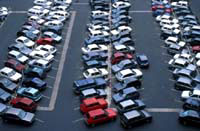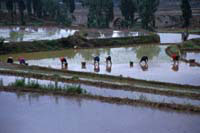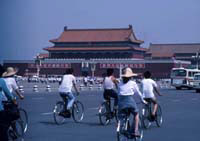As the new century begins, the competition between cars and crops for cropland is intensifying. Until now, the paving over of cropland has occurred largely in industrial countries, home to four-fifths of the world’s 520 million automobiles. But now, more and more farmland is being sacrificed in developing countries with hungry populations, calling into question the future role of the car.

There’s no such thing as free parking.
Millions of acres of cropland in the industrial world have been paved over for roads and parking lots. Each U.S. car, for example, requires on average 0.18 acres of paved land for roads and parking space. For every five cars added to the U.S. fleet, an area the size of a football field is covered with asphalt.
More often than not, cropland is paved simply because the flat, well-drained soils that are well suited for farming are also ideal for building roads. Once paved, land is not easily reclaimed. As environmentalist Rupert Cutler once noted, “Asphalt is the land’s last crop.”
The U.S., with its 214 million motor vehicles, has paved 3.9 million miles of roads, enough to circle the earth at the equator 157 times. In addition to roads, cars require parking space. Imagine a parking lot for 214 million cars and trucks. If that is too difficult, try visualizing a parking lot for 1,000 cars and then imagine what 214,000 of these would look like.
However we visualize it, the U.S. area devoted to roads and parking lots covers an estimated 61,000 square miles, an expanse approaching the size of the 51.9 million acres that U.S. farmers planted in wheat last year. But this paving of land in industrial countries is slowing as countries approach automobile saturation. In the U.S., there are three vehicles for every four people. In Western Europe and Japan, there is typically one for every two people.
In developing countries, however, where automobile fleets are still small and where cropland is in short supply, the paving is just getting underway. More and more of the 11 million cars added annually to the world’s vehicle fleet of 520 million are found in the developing world. This means that the war between cars and crops is being waged over wheat fields and rice paddies in countries where hunger is common. The outcome of this conflict in China and India, two countries that together contain 38 percent of the world’s people, will affect food security everywhere.
Car-centered industrial societies that are densely populated, such as Germany, the United Kingdom, and Japan, have paved an average of 0.05 acres per vehicle. And they have lost some of their most productive cropland in the process. Similarly, China and India also face acute pressure on their cropland base from industrialization. Although China covers roughly the same area as the U.S., its 1.3 billion people are concentrated in just one-third of the country — a thousand-mile strip on the eastern and southern coast where the cropland is located.
If China were one day to achieve the Japanese automobile ownership rate of one car for every two people, it would have a fleet of 640 million, compared with only 13 million today. While the idea of such an enormous fleet may seem far-fetched, we need only remind ourselves that China has already overtaken the U.S. in steel production, fertilizer use, and red meat production. It is a huge economy and, since 1980, also the world’s fastest growing economy.

Assuming 0.05 acres of paved land per vehicle in China, as in Europe and Japan, a fleet of 640 million cars would require paving nearly 32 million acres of land, most of which would likely be cropland. This figure is over half of China’s 56.8 million acres of rice land, part of which it double-crops to produce 135 million tons of rice, the principal food staple. When farmers in southern China lose an acre of double-cropped riceland to the automobile, their rice production takes a double hit. Even one car for every four people, half the Japanese ownership rate, would consume a substantial area of cropland.
The situation in India is similar. While India is geographically only one-third the size of China, it also has more than 1 billion people, and it now has 8 million motor vehicles. Its fast-growing villages and cities are already encroaching on its cropland. Add to this the land paved for the automobile, and India, too, will be facing a heavy loss of cropland. A country projected to add 515 million more people by 2050 cannot afford to cover valuable cropland with asphalt for roads and parking lots.
There is not enough land in China, India, and other densely populated countries like Indonesia, Bangladesh, Pakistan, Iran, Egypt, and Mexico to support automobile-centered transportation systems and to feed their people. The competition between cars and crops for land is becoming a competition between the rich and the poor, between those who can afford automobiles and those who struggle to buy enough food.
Governments that subsidize an automobile infrastructure with revenues collected from the entire population are, in effect, collecting money from the poor to support the cars of the wealthy. In subsidizing the development of an auto-centered transport system, governments are also inevitably subsidizing the paving of cropland. If, as now seems likely, automobile ownership never goes beyond the affluent minority in developing countries, this becomes an ongoing and largely invisible transfer of income from the poor to the rich.
Future Schlock
In a land-hungry world, the time has come to reassess the future of the automobile, to design transportation systems that provide mobility for entire populations, not just affluent minorities, and to do this without threatening food security. When Beijing announced in 1994 that it planned to make the auto industry one of the growth sectors for the next few decades, a group of eminent scientists — many of them members of the National Academy of Sciences — produced a white paper challenging this decision. They identified several reasons why China should not develop a car-centered transport system, but the first was that the country did not have enough cropland both to feed its people and to provide land for the automobile.

Car-free and easy in Red Square.
The team of scientists recommended that instead of building an automobile infrastructure of roads and parking lots, China should concentrate on developing state-of-the-art light rail systems augmented by buses and bicycles. This stategy would not only provide mobility for far more people than a congested, auto-centered system, but it would also protect cropland.
There are many reasons to question the goal of building automobile-centered transportation systems everywhere, including climate change, air pollution, and traffic congestion. But the loss of cropland alone is sufficient. Nearly all of the 3 billion people to be added to the current world population of 6 billion by mid-century will be born in developing countries where there is not enough land to feed everyone and to accommodate the automobile. Future food security now depends on restructuring transportation budgets — investing less in highway infrastructure and more in rail and bicycle infrastructure.


